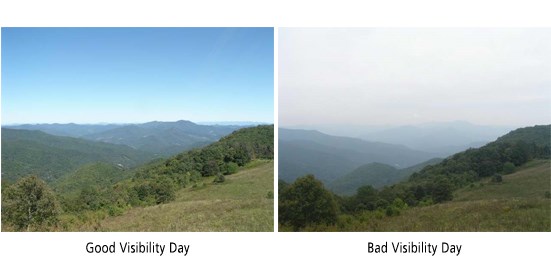
The National Park Service (NPS) keeps track of the visibility conditions in NPS areas and works with air regulatory agencies and partners to improve visibility. Air pollution can create a white or brown haze that affects how far we can see. It also affects how well we are able to see the colors, forms, and textures of natural and historic vistas. Haze is caused when sunlight encounters tiny particles in the air. The particles scatter light into and out of the sight path and absorb some light before it reaches your eyes. The more particles in the air, the more scattering and absorption of light to reduce the clarity and colors of what you see. Some types of particles scatter more light, especially when it is humid. Haze is mostly caused by air pollution from human activity including industry, power generation, transportation, and agriculture. Natural haze from dust, wildfires, and more also occurs in many parks. 
What does haze look like?Air pollution does not significantly impact views on clear days. Also, sometimes weather and not haze is the main thing affecting how well you can see a view.On hazy days, air pollution can be visible as a plume, layered haze, or uniform haze. A plume is a column-shaped layer of air pollution coming from a point source (such as a smoke stack). Layered haze is any confined layer of pollutants that creates a contrast between that layer and either the sky or landscape behind it. Plumes and layers can mix with the surrounding atmosphere, creating a uniform haze or overall decline in air clarity. Plumes and layered haze are more common during cold winter months when the atmosphere moves less. Uniform haze occurs most often when warm air causes atmospheric pollutants to become well mixed. 
How do we know?We monitor air pollution that contributes to haze in parks and around the country. We also track park-specific information about visibility conditions and trends.Research in Parks |
Last updated: October 23, 2024
